|
|
|
|||
|
|
||||
|
|
||||
| The (Jet)X Files | ||||
|
|
HOME | SITE MAP | FORUM | CONTACT |
|
||
|
ABOUT | MOTORS | MODELS | ARCHIVE | HISTORY | STORE | FAQ | LINKS
|
|
|
|
|
|
|||||||||||||||||||||||||||||||||||||||||||||||||||||||||||||||||||||
|
The (Jet)X Files 9
(September 2003)
by Roger Simmonds Reprinted from SAM 35 Speaks, September 2003 This month I will address a number of comments, questions and requests for information that have built up over the months. This will inevitably lead to an article that is even more discursive than usual, so I have included sub headings to introduce new topics. Rocket Plane History |
|
|||||||||||||||||||||||||||||||||||||||||||||||||||||||||||||||||||||
|
Peter Tollhurst sent me a most relevant “Vintage Corner” that appeared in the January 1993 copy of Aeromodeller. This particular example of Alex Imrie’s series of articles includes a fascinating extract from the January 1913 edition of Flight that helps fill in the UK “rocket plane saga” between 1907-1914. V E Johnson (the editor of the Flight ‘Models’ column) made some interesting comments on rocket power in answer to one of his correspondents, L F Hutcheson. Hutcheson had a “single stick pusher” (whatever that was) 29" long but only 18" span. It weighed 1½ oz, and was powered by 3 a penny ‘rockets ’. On the third attempt, it “rose to about 4 feet and covered 20 yards, only descending because of ‘switchbacking’ due to over-elevation”. Johnson replied that he had made a number of experiments with penny rockets and obtained a flight of 150 yards three years earlier, but he gives no details of his model. However, he does mention a competitor at an early Crystal Palace model aeroplane meeting, who “flew a rocket powered model to the great disgust of the other competitors, whose language and remarks were more forcible than polite. The model made one flight at great height covering 100 yards, but then dived vertically, smashing itself to smithereens”. This competitor was of course, none other than our Mr Thomas (see the May Jet(X) Files). Clearly his achievements were not appreciated in his own time. I too have experienced language more “forcible than polite”. I wonder what became of Mr Thomas. Johnson himself had an ambivalent attitude to rocket power (“we are not advocating ‘rocket motors’ …we merely wish to place a few quiet unbiased facts before our readers”). He did however allow it might be of some use in “aeronautical work”, and suggested, “the rocket should be attached at the centre of gravity of the machine if possible. Owing to the extremely energetic nature of the motive power … the centres of gravity, (and) of head resistance should be coincident and the propulsive action pass through this same point”. Sensible advice even today. |

- RAF Flying Review, 1958
|
|||||||||||||||||||||||||||||||||||||||||||||||||||||||||||||||||||||
|
This ‘Vintage Corner’ also featured a very attractive all-balsa twin boom machine [right]. This was apparently a free plan in the June 1939 Aeromodeller. After giving advice on what rockets to buy, (“coloured stars are apt to be superfluous etc”…) the designer, one J R Singer Craigie, tells readers to “balance each wing tip on an empty bottle. … Light the touch paper. If you have put the correct down-thrust in the rocket the plane will climb steeply to about fifty feet and pull out into a good flat, but rather fast, glide”. This model, if not its mode of launching, appears quite practicable and suitable for Rapier power. Ben Nead, the founder of Jetex.org, confirms that the rocket plane in Lawrence Sparey’s wartime Model Engineer article bears a remarkable resemblance to a design by G Haase that first appeared in a pre-war German publication, and later in Frank Zaic’s 1944 book on glider design. It is really very elegant and eminently suitable for Rapier power. The plan, and a number of similar ones from the same period, can be downloaded from the Jetex.org website. Ron Knight sent me a copy of “How Howard got a Rocket (or Boys will be Boys)” from very first SAM 35 Yearbook. Howard Boys reminisces about his first attempt in 1931, “I was a bit half hearted … a wing and tail were put on an ordinary firework rocket. These were adjusted to give a reasonable glide with a spent rocket and then put in a similar position on a loaded rocket, hoping that the altered CG would keep the nose down. It didn’t work” Howard continues, “ I later experimented with small tailless models powered by “aerial torpedoes”. This was more successful … tailless models were continued with rubber motors and I gained two British records”. I’m not sure if Howard was ever involved in the Jetex scene, as he had by this time become interested in radio control. Profile Models Stan Pearson observes that Bob Linn’s 1954 Super Sabre chuck glider is, like the real thing, prone to the occasional flat spin (SAM 35 Speaks, July 2003). Funf asks whether anyone contemplating a scale model would do well to try a profile model first to see if the dreaded “roll coupling” manifests itself. Now such a ‘mock up’ (with built up wings) may have its uses for an especially outrageous prototype, such as the XB-70 Valkyrie or X-36, in order to sort out rigging angles and CG, but the received wisdom is that profile models are even more prone to “roll coupling” than the built up versions, and of little use in predicting the flying characteristics of a proper model. Modern experience confirms this, and Howard Metcalfe says that he had to reduce the nose areas of some of his profile scale models to correct their spinning tendencies. |
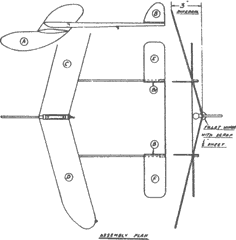
- Aeromodeller, Jan. 1993 (p. 14)
|
|||||||||||||||||||||||||||||||||||||||||||||||||||||||||||||||||||||
|
|
|
|||
|
Similarly, roll instability can also be a problem with our models. It took model designers some time to realise that highly swept wings required little or no dihedral, and the notorious KeilKraft Skyjet [right] and Hawker Hunter in particular were prone to ‘Dutch rolling’. Again, a profile model, with all that effective side area, will not be predictive of how much or little dihedral (or anhedral) the true-scale model will need. I myself have an aesthetic aversion to profile models (though I will make an exception for Howard’s brilliant ‘semi profile’ MiG 29) and maintain that the term ‘profile scale’ is an oxymoron, but I know they are very popular and many people have lots of fun with them. I have therefore sent the editor many plans of profile models (including a Handley Page 115 designed by Doug McHard, who certainly wasn’t, according to Stan, a “Jetex man”), and I trust that these will appear in due course and at the editor’s discretion. Rapier Motors The editor has asked whether ‘Rapiers’ are the only motors suitable for our sorts of model. I’m afraid that at the moment Rapiers appear to be the only game in town, at least for those without old Jetex motors and supplies of fuel. However, Carlo Godel and others in the US hope to produce two new motors of low thrust and long duration. One will be equivalent to a Jetex 50; the other will be larger and have a thrust equivalent to the Jetmaster. This will be suitable for the many superb ‘PAA Loader’ duration designs and, I hope, the larger ‘Tailored’ Swift and Hunter. I hope to report progress with these ‘Titan’ motors soon. Estes, the well-known manufacturer of the high power motors for rockets, were approached in the early eighties, but they were not at that time interested in the small market that motors for small model planes represented. It must be emphasised that the Estes motors, even the latest ‘AP10-PT’ variety, are most definitely not suitable for our models, whether these are from modern kits or old plans. Estes motors should only be used in properly designed ballistic rockets and never instead of Rapiers. Power Loadings |
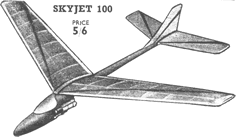 ’climbs like a rocket and glides like a gull“
- Model Aircraft, Nov. 1948
|
|||
|
Many models are quite sensitive to “motive power” (Johnson’s nice phrase), and can become quite intractable with motors above a certain critical value of thrust. The Bell XS-1 is a fine flier with L2 motors in the 90-130 mN range, but tends to be ‘twitchy’ beyond this, and my DH 108 Swallow [right], is also happiest at low power. This is a problem as the specific impulse of Rapier motors varies from batch to batch, and the specifications indicated on each box may not be reliable guides to what the contents deliver. The first flight of a model with a new batch of motors is always, therefore, an interesting and informative experience. Now this can be irritating, but it suggests a trimming strategy that was not available to our Jetex forbears, so that this apparent fault of Rapiers can be turned to our advantage. A new design can be tried with motors of different ratings, and the range of ‘optimal thrust’ discovered experimentally. If successful, the only trouble then is to secure adequate stocks of the ideal batches. This strategy is now quite feasible because Jan Zigmund is now deliberately (rather than inadvertently) producing variations to his established (L1-L4) range. For example, there is the ‘L2 LT’, which has an 80 mN thrust (about 0.3 oz, a little less than an Atom 35), and a 26-30 sec duration. These motors are ideal for the smaller scale designs, and I look forward to trying them in my In contrast, some designs appear power hungry. To feed these, higher power |

- Roger Simmonds
|
|||
|
For example, Pete Smart’s thin-winged FD 2 has a tendency to wallow about with an L2 HP of a nominal “220 mN” thrust. However, he reports that the flying characteristics are quite transformed with the new |
 Richard Crossley
- Chris Strachan
|
|||
|
Augmenter tubes The need for such a device was manifest long before their introduction in 1953. Several designs before this date specified Jetex units buried in fuselages with little or no protection, and little thought of the effect on the motor. D P Golding’s 1949 Swallow and the Miles Student (where the exhaust fed into a parallel paper tube) are obvious examples. Wilmot Mansour took great pains with their product, and the ‘thrust augmenter tube’ was developed in collaboration with N K Walker and the Low Speed Aerodynamics Research Association. Two new motors, the Scorpion and the Jetmaster [see right], and a modified Jetex 50, (the 50B), were introduced to match two diameters of augmenter tube. R H Warring’s ‘Engine Analysis Supplement’ in the January 1954 Aeromodeller is a fine example of his academic and slightly patronising, not to say quasi-ecclesiastical, writing style. First, he comments on the new nozzle shapes. “A bluff trailing section in the bell mouth entry almost certainly creates turbulence of an order serious enough to impair the efficiency of the augmenter, and both the new Jetmaster and the 50B were designed with shaped nozzles to match the contours of the bell mouth”. A significant thrust increase was found for the Jetmaster, but augmentation of the 50B was marginal and observed using only the bell mouth intake (see graphs [right]). Warring concedes that his static tests, “do not necessarily duplicate results which might be obtained under flight conditions”. He correctly predicts that the units would not be useful for duration models, but says, “Provided the set-up is reasonably accurate the designer should certainly get no loss of thrust and most possibly a gain if a properly ducted entry is associated with the location of the bell mouth. This latter feature may be somewhat critical on certain layouts”. Unfortunately, no definition of “reasonably accurate” or how to achieve a “properly ducted entry” is given. Nor does he make any attempt to explain how augmentation is actually produced. However, we can agree with his conclusion, “Transposing the point of free exit of a jet stream without loss of thrust is an accomplishment of no mean order and for this reason alone augmenter tubes are a welcome innovation”. Amen. The question of whether augmenter tubes actually can increase thrust, and how this might be effected, remains contentious. Edward Jones, founder of the Rocket Science Institute, writes the following, “Before the thrust augmenter tubes were produced it was impractical to mount the motors inside a fuselage or wing, as the method of mounting inevitably caused swirls or drag on the jet effluxes. All Jetex motors work at maximum efficiency when there is minimum turbulence around the jet stream and any restriction of airflow round the motor causes loss of thrust. The augmenter tube increases the thrust by smoothing out the air flow around the motor and ensuring proper mixing of the heated and expanding jet effluxes with the surrounding air”. Here he may be quoting some Wilmot Mansour publicity material. In truth, we just do not know whether the augmentation of thrust, if any, is produced by the increased mass flow through the tube or by directing (collimating) the exhaust in a single direction. There has been much discussion about this in the ModelJetPlane discussion group. It would appear that Rapiers are not as incompatible with augmenter tubes as was first feared, despite their bluff end and hot and dirty exhaust. A single “optimum” design for different batches of motor is not possible, as many factors such as thrust exhaust temperature and velocity must be taken into account. Ideally, a tapered tube with an included angle of 5° is required, but for our purposes we can usually get away with less than maximum thrust, so I suspect that many people will, like me, opt for a straight tube. Carlo Godel has made Augmenter tubes are effective only if there is an adequate air intake. Reaction motors will not work in an enclosed tube, and this has a bearing on trough design. Because Rapier motors are slimmer than the corresponding Jetex units, there is a temptation to deepen and narrow the trough of old Jetex designs, However, this can be taken too far, and the exhaust can be impaired and thrust reduced. To counter this, some experts arrange airflow over the motor, ideally from scale air intakes, and this not only restores thrust but also reduces fouling of the trough. |

- Bruce Ogden
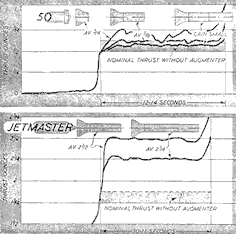
- Aeromodeller, Jan. 1954
|
|||
|
Though the science of augmenter tubes is uncertain, and their application complex, they not only made the superlative, and equally innovative ‘Tailored’ kits possible, they also inspired independent designers, and some very interesting plans for models of contemporary jets were published in UK, European and US magazines in the 1954-1958 period. There was the Boulton Paul P.111A [right], Folland Midge, YF-92 and a very nice French YF-102, to name just a few. It seems a great pity that neither KeilKraft nor Skyleada made any kits for augmenter tubes. It may be they were thought too complex, or perhaps by this time interest in Jetex power was on the wane and such kits would not have been viable. Another FD 2 |
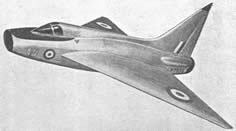
- Aeromodeller, May 1954
|
|||
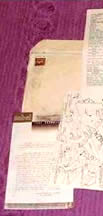
|
|
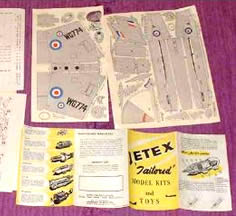
- Andy Blackwell
|
||
|
|
||||
|
|
|
|||
|
|
|
|
|
|
|
|
Acknowledgements - Article: Roger Simmonds - Illustrations: Andy Blackwell, Bruce Ogden, Roger Simmonds, Chris Strachan, Mike Thomas, Peter Tolhurst, MAAC archives via Bill Henderson |
|
|
|
|
ABOUT | MOTORS | MODELS | ARCHIVE | HISTORY | STORE | FAQ | LINKS |
|
|
Terms of Use
|
Queries? Corrections? Additions?
Please
contact us.
|
|